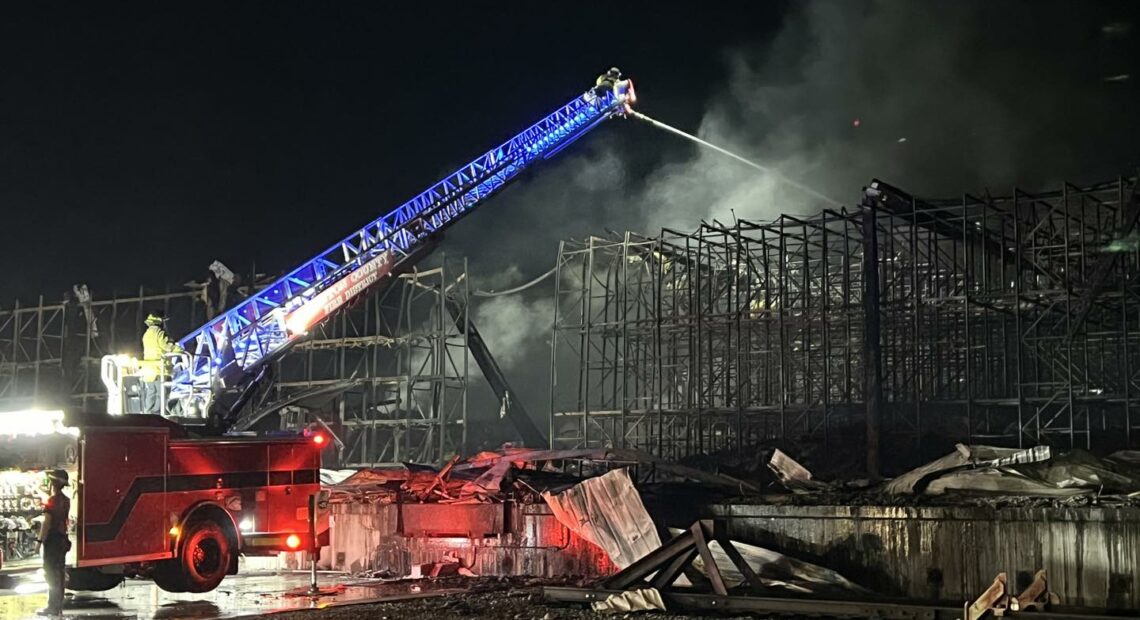
Tri-Cities’ largest warehouse fire still smoldering, spitting out potentially toxic smoke
Listen
(Runtime 1:00)
Read
A month in and the largest warehouse fire in the Tri-Cities is still smoldering, kicking up plumes of potentially toxic smoke.
Now, health officials will install stationary and handheld air monitoring devices, looking for tiny particles that can exacerbate lung and heart issues.
The state Department of Ecology plans to monitor for chemicals, including hydrogen sulfide, an extremely hazardous gas that smells like rotten eggs, and other volatile organic compounds, said Emily Tasaka, a spokesperson for Ecology.
“Hopefully this will give us a sense of which areas are receiving higher levels of particulates,” Tasaka said.
The Lineage Logistics cold storage warehouse first caught fire April 21 in Finley, Washington.
“You’ve got wooden pallets, you have plastic pallets, you have cardboard boxes, you have food that was once frozen and is now rotting,” said Jenna Kochenauer, the spokesperson for Benton County Fire District 1.
Now, all that mushy mess is drying out in the sun.
“That’s creating new fuel for the smoldering wood and plastic and cardboard to ignite when winds pick up,” Kochenauer said.
Rumors have swirled about what, exactly, is burning in all the debris. Nearby residents are ready for the smoke to cease, but officials say, with the upcoming demolition, the situation will likely get worse before it gets better.
The Benton Clean Air Agency isn’t set up to test for toxics, but it’s gathering data, said Rob Rodger, the agency’s executive director.
“The toxics require much more sophisticated monitors, and they aren’t mobile, generally,” Rodger said. “Basically, we’re finding out where the smoke is going and the smoke levels.”
Even though this is a large structure fire, the smoke pollution is similar to structure fire smoke, Kochenauer said, noting all smoke is toxic. Nearby residents can wear N95 masks, avoid strenuous activity outside and set up box-filter fans to help clear inside air, she said.
Ecology will place a PM-2.5 monitoring station down the road from the fire, Rodger said. PM-2.5 is tiny particulate matter, which is many times smaller than the width of a strand of hair.
The fine particles can make it deep into lungs and exacerbate respiratory and heart issues, raising concerns with the inhalation of structural and wildfire smoke.
Ecology also plans to monitor for PM-10 particles, which are larger than PM-2.5. These larger particulates can include dust from construction sites, soot and burning waste.
With all the complications, smothering the fire is not an easy task, Kochenauer said.
“If you think about Costco in Kennewick, the Lineage facility is about three and a third of those Costcos that’s all just collapsed to rubble,” she said.
That’s about 525,000 square feet, or nearly three-quarters the size of Seattle’s Climate Pledge Arena. Fire crews can’t reach some of the smoldering piles without placing themselves in danger, Kochenauer said.
“Our fire chief lives two houses away from the fire,” she said of Benton County Fire District #1’s new Chief Scott LoParco. “He is right there in the middle of it, along with the rest of the folks who live in that surrounding area.
However, firefighters hope they’ll be able to reach further into the facility soon, Kochenauer said.
Demolition crews this week started tearing through debris to reach the trickiest burning piles in the interior of the warehouse.
Flare-ups tend to happen as the wind picks up at night, Kochenauer said.
“That has been our biggest challenge: trying to get enough water to be able to try to reach the areas that are flaring up in order to prevent that smoke that’s really impacting the folks who live around the lineage logistics facility,” she said.
With no nearby fire hydrants, crews have trucked water 3,000 gallons at a time on a water tender.
The fire district asked for help determining the fire’s cause from the federal investigators. The Bureau of Alcohol, Tobacco, Firearms and Explosives has yet to release its findings.
Crews said the fire could smolder for another month.
Correction: This story has been updated to clarify that all smoke is toxic, but any structure fire will have more toxins than a wildland fire. The toxins in the Lineage fire smoke is similar to any structure fire, not wildland fire.
















